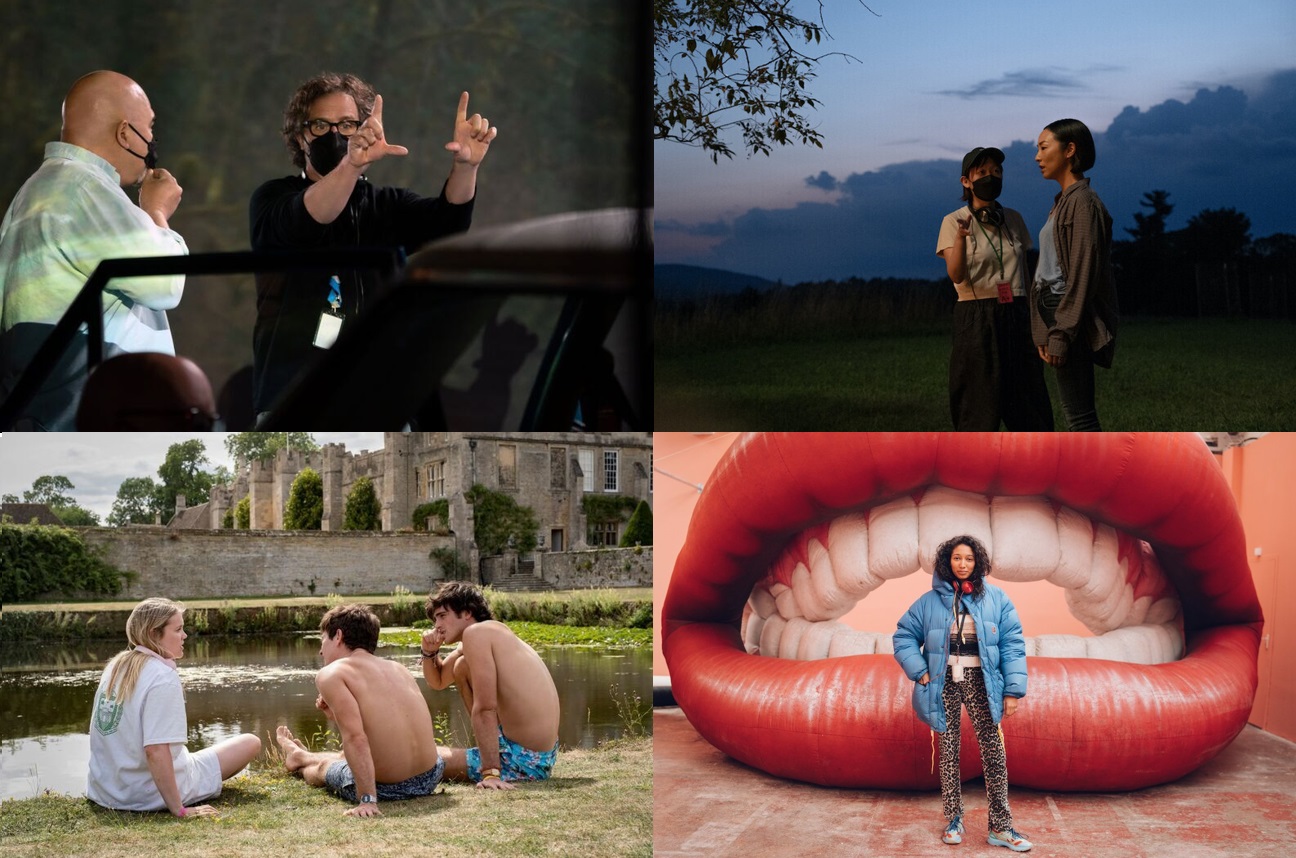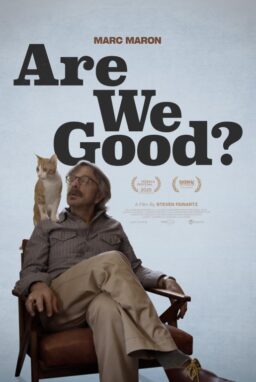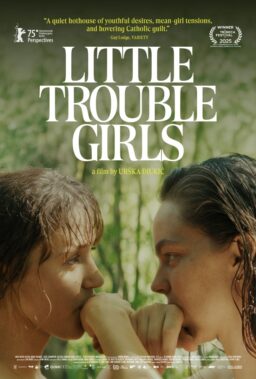Conversation is essential to art, and we had some great ones this year with actors, directors, writers, and craftspeople of all kinds. We wanted to share just a few of our favorites with a quote from each and a link to read more. Check them out and read many more interviews here. Thanks to everyone who took the time to chat.
Interviews conducted by Nick Allen, Matt Fagerholm, Isaac Feldberg, Marya E. Gates, Rendy Jones, Nell Minow, Collin Souter, and Brian Tallerico.

Andrew Haigh on “All of Us Strangers”
There’s a time travel to feeling certain emotions, to smelling certain smells. The way memory works, and how powerfully it can take us back, was something I wanted to play with, so you lose all sense of existing in a present. It’s the same with how the film ends; there’s no sense of it being a linear progression of time. I was excited and nervous about that. All my other films have been very secure in their timescales. I wanted to go off-piste and do something else.

Cord Jefferson on “American Fiction”
I would ask, what is the preferable response? Is it better to make a movie in which we see racism and violence enacted on black people, and then instead, a room full of white audience members gasps or cries and pities those characters? Is that a preferable use of those images in art? And if so, why? And I’ll just say that I don’t agree with that take. I don’t think that there’s some superiority to one response to those images versus another. I don’t think that using those kinds of images in order to make people weep or feel bad is preferable to using those kinds of images and that kind of material to make people laugh.

Charles Melton on “May December”
So much can be said without saying anything at all. We can tell a story through physicality and kind of diving into it. This will sound so heady, but the psychology of just arrested development, repressed emotions, how they live in the body, and how they can translate. Joe doesn’t move his mouth too much. He’s afraid to be very pre-verbal and does not want to be seen or show himself. So, what would repression sound like? And it kind of comes from the gut and the throat, which is almost where his certain performances inspired me—for example, Heath Ledger’s performance in “Brokeback Mountain.” I mean, the feeling is similar, the sense of repression, but just how he kind of carries himself. Then Tony Leung in “In the Mood for Love,” where he communicates so much with just his face and what’s going on. I had a few things that I would just do; there’s much technical work that just transformed Joe’s external expression.

Meg Ryan on “What Happens Later”
No, but banter is so important. Like for “His Girl Friday,” I remember reading that Howard Hawks would have Rosalind Russell and Cary Grant rehearse with pencils in their mouths so they could be super articulate. Since they are meant to be together, those two characters have the same rhythm, intellectually, and the same rhythm of banter. And the guy she’s not supposed to be with, Ralph Bellamy, talks not at all in the rhythm. So, I think these are part of why we love these movies has to do with banter. And that’s all about being rhythmic.

Raven Jackson on “All Dirt Roads Taste of Salt”
I know what I’m looking for, but I’m open to how I get there. And I really do feel the script is a starting point for me. I know what I’m looking for, but the day of, I’m very present, and if something isn’t working, I think I’m good at being very like, “Oh, something feels off here,” and trying to figure it out by going through what it could be, whether it’s blocking, costuming, etc. You know what I mean? Like, what is not working? So I think though I know what I’m looking for, I tried to be loose on set so I can be open to something better. A surprise. There were a lot of pivots we had to do on the film. One of them became our first key image! It’s just like being open to the potential. I really tried to do that.

I’m non-binary. In many ways, this film is not explicitly queer, but there’s a lot of implicit questioning that comes from a deep, subliminal place in me. That’s why I relate to Rose so strongly. I remember learning about the concept of being non-binary when I was already in my 30s. I said, “How cool. I’m too old but, if I knew about that when I was a kid, that’s what I would be.” I had a really hard time, because of socialization, realizing it wasn’t too late for me. There’s so much unlearning.

Throughout the film, bicycle riding is a place of reverie. It’s a pause between conflict and connectedness to some place in which he’s technically alone. And yet, the camera can watch. That’s one great thing that the camera can do: watch people when they’re alone. It’s a great oxymoron. In my films, often, there are moments like that. In “Love is Strange,” there’s a scene with a teenage kid crying in a stairwell. He’s just left Alfred Molina’s apartment, he’s alone, and he breaks down, but we’re there. That’s what the camera can do. You can be there when you’re not there. The camera’s there with the characters in the sex scenes, but it’s also not there, because you’re not allowed very close.

Griffin Dunne on “After Hours”
It is a comedy, but it also is an entirely original way to get laughs. It hadn’t really been done. It’s kind of a genre unto itself that has been imitated or has influenced a lot of other movies since, but we always found the situations hilariously funny because it came out of real situations that were incredibly awkward and anxiety-ridden. In the earlier screenings, people had a hard time, especially when we didn’t have the ending when Paul ended up in the back of the van with no release. Sometimes it was just too much for an audience, just feeling anxious and worrying about this guy and whether he would get home or not. But I think it started a genre of anxiety-driven comedies.

Ted Geoghegan on “Brooklyn 45”
I will also say that I directed the film like a stage play, and every single day I had very specific movements for all of the actors. I gave them a little index card, and I called them their dance cards, and it showed them where they would be moving that day. The card was a map of the room. I had to keep extremely tight reins on where everyone was in the room, because I needed them to be in certain places at certain times, and it was important that they found their way to those spots organically.

I think part of that is that it makes every relationship we have, or even every encounter we have, have weight and have meaning and depth. Because if you can think of the person who gave you a cup of water as a person that you have In-Yun with, yeah, then I think that the way you think about that person, the way you treat that person, and the way you care for that person changes. I think In-Yun can be a pretty amazing thing that one can have.

Davis Guggenheim on “STILL: A Michael J. Fox Movie”
I asked him, “Is this a story about a sad sack guy who gets a chronic disease, and it crushes him?” He takes a long pause and says, “That’s boring.” And when the movie plays in an audience, it’s a huge laugh. Huge laughs and the way he is now. But I think it’s also shocking for us to see how Parkinson’s has really changed his physicality. How he walks and how he looks, and how he speaks. I think it’s hard for us to imagine Alex P. Keaton or Marty McFly to be like that right now. But what’s sort of wonderful is how his spirit endures. He’s still that puckish guy who wants to win.

You’re absolutely right. But you know, the rise of Letterboxd shows us that there is a growing cinephile audience that is getting younger and younger. I think that audiences are always finding ways to stand out, to have niche tastes. While the internet does level everything, it does also create niche groups. It creates clubs. Discord, Tumblr, and even Reddit, in a broader sense, show us that people are looking to find very specific, very exclusive cliques. I think that cinema is benefiting from that. Now you’ve got people being like, “I love Rohmer, and this is my little Rohmer Club.” It’s cool to like them with these people, and you can help create an identity. If you’re growing up in the ‘80s and you’re watching movies in the cinema exclusively or on television, audiences are not responding and seeking these films out in the same way they are now. They’re being more active. It’s become a part of people’s personal branding. People’s Letterboxd are carving out an identity for themselves using their cinematic tastes. And that is new.

Raine Allen-Miller on “Rye Lane”
Working with a DP that knows how to light Black skin is so important, obviously. I think, especially when “Moonlight” came out and “Insecure,” there was so much talk about how well the Black skin people had been lit. And I think it’s ridiculous that it didn’t happen sooner, right? But Olan Collardy is brilliant, and color is such an important part of what I do. I think regardless of someone’s skin tone, I love to inject color into everything that I do. And Olan also really enjoys that. We just had fun, and we wanted to light people properly. That’s the thing, right? It wasn’t like, “We have to light Black skin.” It was like, “Let’s light these people properly.”

Chad Stahelski by “John Wick: Chapter 4”
It’s funny, you jump out of a plane, and not a lot of people can relate to that, but everybody can relate to slipping on ice. Everybody can relate to getting hit by a door or punched in the face or kicked in the groin. I guess that was what was so effective when I watched Buster Keaton or Harold Lloyd, or Jackie Chan, for modern-day cinema. Sometimes, the more relatable pain or humorous pain, if the audience can experience it with the character on-screen, it becomes more effective. No one has jumped 300 feet in a car. Although it’s visually impressive, it’s hard to know what it’s like and to feel that. So we try to keep the gags and the stunts where you go, “Ooh!” and crying out. That’s kind of my fetish, I like everybody to feel the same thing the characters feel.

I often say that I feel like I can learn a lot—we can learn a lot—from listening to 13-year-olds, because what I feel is that they are still strongly connected to the heart, and we tend to lose that as we grow older. We start to say things because society expects and accepts us to say them. I find that there is a sort of pure radicalism to what kids can say that goes to the absolute essence of things. I had Eden and Gustav read the script before the last round of casting because I wanted it to not only be us choosing them, but also them choosing us, and this conversation that we had around it was extraordinary. I do feel that how they reflected on the script really reshaped what the film became—not the dramaturgy, the framework or the other big things, but the nuances. One thing that I said to them very early on is, “I don’t care about what the sexuality of these characters are or what your sexuality is either because we don’t need it to tell this story.” So that topic was not present in our conversations.

Kyle Edward Ball on “Skinamarink”
That’s in part why I’ve gravitated toward the lo-fi aspect of movies. Since I was a little kid, I’ve wondered why they don’t make old movies anymore; there’s an obvious reason for that, but I always felt that movies from the ’70s make me feel differently than movies today do. Movies and cartoons from the ’40s, media of different ages, spark something in me, and in other people, that you can’t quite put your finger on. Also, good horror movies that are creepy, but not necessarily scary, only get creepier with age. When it came out, “The Shining” didn’t necessarily get the response it gets today, and that’s because it’s not scary. It’s creepy, and creepy only gets creepier with age. Scary fades. Creepy is forever. Creepy, you can’t wash away.











